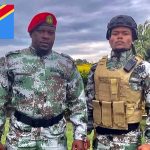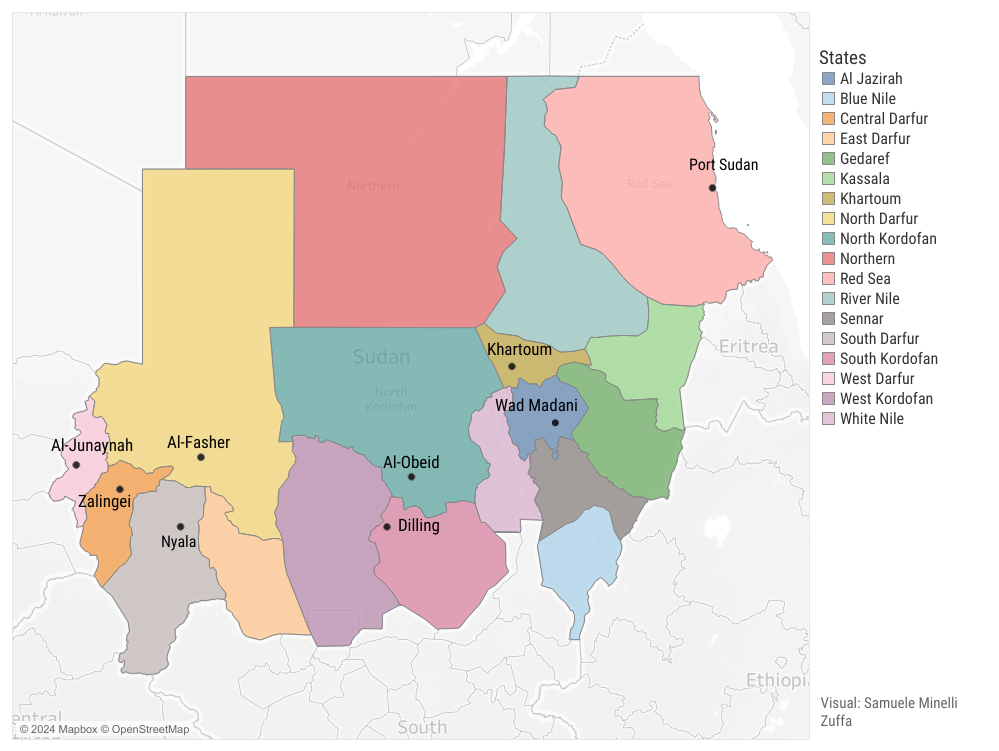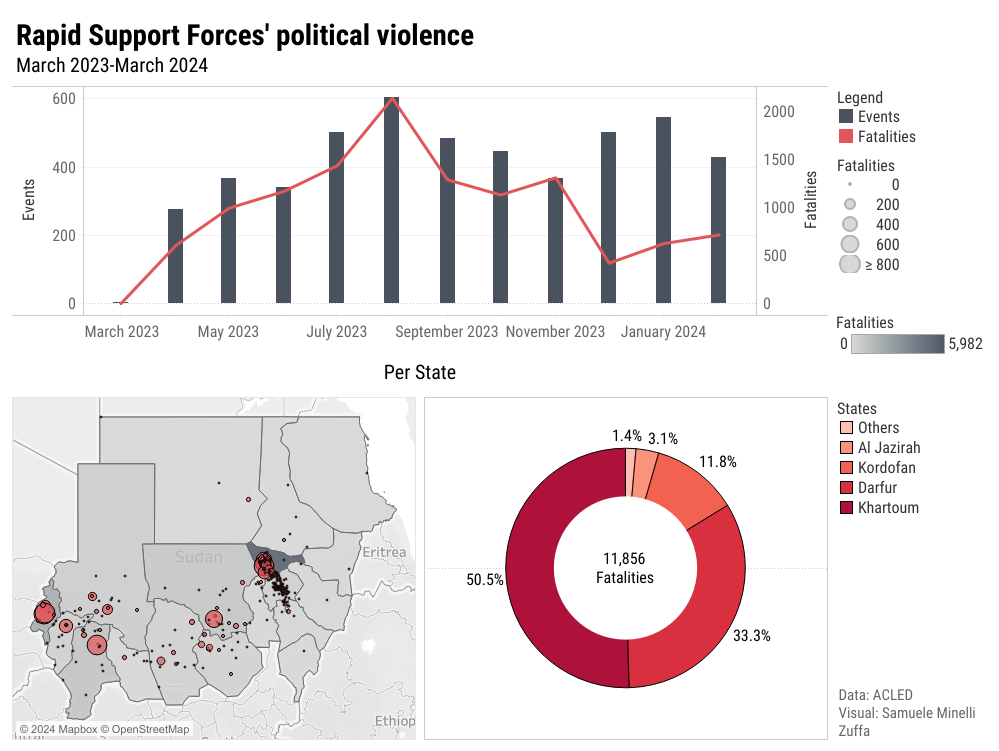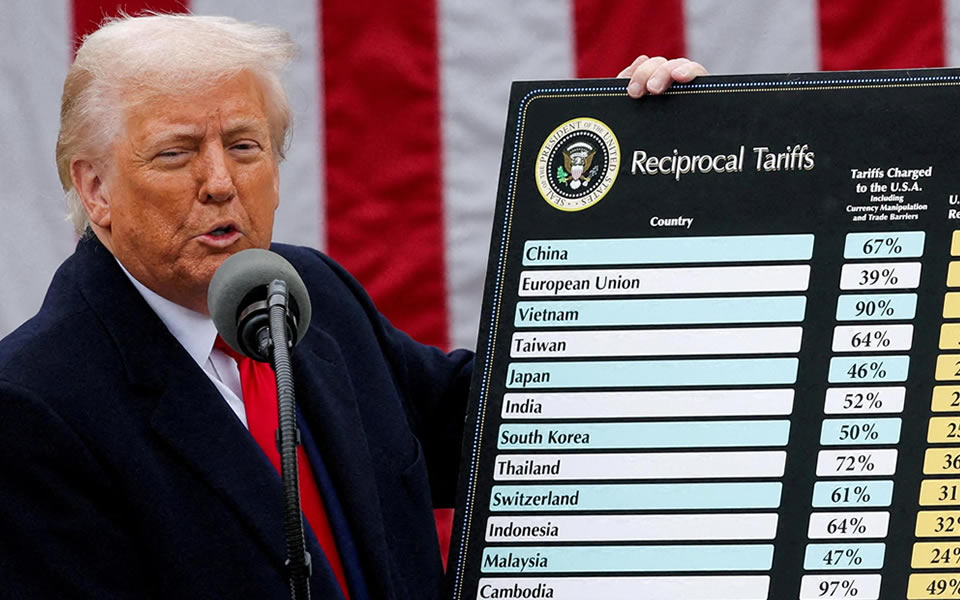
Attempted Coup in the DRC: Overview & Implications
May 24, 2024
Interactive Dashboard: JNIM’s political violence
June 25, 2024STATE OF VIOLENT EXTREMISM - RAPID SUPPORT FORCES (RSF)
Analysts: Samuele Minelli Zuffa
Senior Editor: Magdalena Breyer
What You Should Know
- Operational Region: RSF is mainly operational in the Khartoum, Darfur, Kordofan and al-Jazirah states. The principal disputed hotspots are Bahri City (الخرطوم بحري, Khartoum), al-Fasher (الفاشر, North Darfur) and Dilling (الدلنج, South Kordofan).
- Goals: RSF seeks to maintain its strategic independence and reduce the influence of Islamist components in Sudanese politics. RSF's main strategic goal is to expand control over Sudan’s mineral resources and territory before starting peace negotiations. Acquiring the Khartoum-Omduran-Bahri complex is their primary ambition, while securing Darfur and the supply route from Darfur to Khartoum are complementary goals.
- Shift in Tactics: The group’s activities increased 20-fold between March 2023 and March 2024, compared to the prior one-year period. The outbreak of confrontations with the Sudanese Armed Forces (SAF) very likely accounts for armed clashes, artillery attacks, and drone strikes recording the highest increases. Despite accounting for only 2% of its activities, sexual violence increased 50-fold from the previous year.
- Expansion in 2023: RSF repeatedly defeated SAF in Darfur, Kordofan, Khartoum, and al-Jazirah states, achieving multiple strategic victories. RSF conquered the majority of al-Jazirah and Darfur states, except North Darfur. The seizure of Wad Madani (al-Jazirah) in December 2023 was a significant gain due to its strategic position for controlling the capital city, Khartoum.
- Forecast: RSF will very likely continue to hold the majority of its positions in the three-city complex of Khartoum-Omduran-Bahri despite SAF's victory during the February offensive. Wad Madani (Al-Jazirah) will likely be one of the principal conflict epicentres over the next six months. RSF's ethnic cleansing and targeted rape will very likely fuel public support for other warring parties fighting alongside the SAF to counter RSF's advances in Darfur and Kordofan. International support for the RSF will possibly diminish over the next six months, as demonstrated by the Russian official visit to SAF leader, al-Buhran.
Introduction
RSF has largely dominated the Sudanese Civil War, defeating the SAF multiple times and conquering several areas from Darfur to al-Jazirah over the past year. In February 2024, the SAF’s Omduran offensive caused the first major defeat for RSF, likely marking a turning point in the civil war. SAF’s prolonged military victory remains unlikely amid the RSF's continued solid presence in eleven states.
This assessment examines RSF’s operational area, tactics, and impacts in Sudan between March 2023 - March 2024. As RSF leader General Hemedti attempts to raise his legitimacy with an international diplomatic tour, understanding RSF’s recent developments is critical to foresee strategic shifts in the civil war.

Rapid Support Forces' emblem
Geographical Areas of Activity in 2023
RSF operated in the Central African Republic, Chad, Ethiopia, South Sudan, and Sudan over the last year, with over 99% of incidents occurring in Sudan. While Darfur and Khartoum states are the main affected areas, 18% of the RSF-related fatalities occurred in al-Jazirah and North Kordofan states. This is likely attributable to North Kordofan's role as a crucial supply link between RSF strongholds in Darfur and Khartoum. The expansion into al-Jazirah is very likely strategic for controlling the upstream Blue Nile and continuing the military acquisition of western areas.

Timeline of Key Events
Late 80s
The Janjaweed militias, (جَنْجَويد) pan-arab militias, form in the Darfur region with Libyan support, playing an active role in the Chad-Libyan war’s final stages.2003-2005
Following the beginning of the insurgency in Darfur and South Kordofan against al-Bashir’s rule, the Janjaweed militias sided with Sudan's central government, systematically targeting civilians and sexually assaulting women of the opponents’ group.2013
President al-Bashir fosters RSF’s creation from Janjaweed militias led by Hamdan Dagalo (Hemedti) to combat internal rebellions in Darfur and Kordofan while counterbalancing the power of the SAF and the National Intelligence and Security Service (NISS).2021
RSF and SAF jointly lead a military coup, co-opting the popular revolution that toppled al-Bashir’s regime in 2019.April 15, 2023
outbreak of the civil war. Hostilities erupt between RSF and SAF over the timeline for RSF's independence and progressive integration into the national army. In the first months of the war, RSF consolidates control of Darfur but fail to capture Khartoum fully.October-November 2023
RSF capture the capital cities of South, Central, and West Darfur states, with ethnically motivated killings and sexual violence characterising these military advancements.December 2023
RSF conquer Wad Madani city, the capital of al-Jazirah state, causing the displacement of roughly 300,000 people.February-March 2024
SAF reconquer significant areas of Omdurman city (Khartoum) after significant defeats of RSF.
Tactics and Techniques
According to ACLED, approximately 5505 incidents involving RSF caused at least 11,865 fatalities between March 2023 - March 2024. The distribution of incident types is as follows:
Armed Clash
Shelling, artillery & missile attack
Air/Drone Strike
Attack
Change to group / Activity
Others
RSF Tactics, Techniques & Procedures (TTP) and capabilities are characterised by:
Armed Clashes
RSF principally clashed with SAF. The main theatres of the clashes were the three-city complex (Khartoum-Omduran-Bahri), al-Jazirah state, Dilling (South Kordofan), and in the surroundings of Al Fashir (North Darfur). Other conflicting parties also confronted RSF in different areas, including Sudan People’s Liberation Movement-North (al-Hilu) in South Kordofan and the Sudan Liberation Movement (al-Nur), who seized the Tawila and the Marrah mountains (East and North Darfur). Several Sub-Saharan communal and ethnic militias confronted the RSF in the Darfur and Kordofan areas
Civilian Targeting & Sexual Violence
Civilians constitute 45% of RSF-related fatalities. RSF systematically targets civilians, using rape, forced marriages, and sexual violence to intimidate and punish non-Arab communities, especially in Darfur and Kordofan. The RSF is responsible for approximately 70% of the reported sexual violence since April 2023. RSF’s destruction of Misterei (West Darfur) in May 2023 and conquest of Ardamata (West Darfur) in November 2023 resulted in the ethnically motivated killing of thousands of civilians and the rape of dozens of women and girls.
Property Arson
Fires ravaged more than 100 villages since the beginning of the hostilities in April 2023. The majority of the fire incidents occurred in Darfur and Kordofan areas. RSF repeatedly perpetrated arson against non-Arab communities, with some arson cases being a collateral result of fighting. RSF's repeated burning of Misterei (West Darfur) between May and October 2023 and al-Takma (South Kordofan) in December 2023 highlights their use of fire as a war tactic.
Gold Production & Smuggling
Since 2017, the RSF’s leadership has acquired exploitation rights over several gold fields, boosting RSF’s revenues and rise to power. The United Arab Emirates is the RSF's primary commercial partner.

Impact Over the Last Year
RSF’s impact varies considerably depending on the analysed region.
- Khartoum: Attacking from the international airport of Khartoum, the RSF seized ample sectors of the three-city complex (Khartoum-Omduran-Bahri) during the first weeks of the civil war. Widespread civilian targeting, sexual assaults, and looting characterised RSF’s offensive. In February 2024, the SAF successfully broke a ten-month siege of the military district of the Engineers Corps in southern Omdurman city. Iranian drones substantially supported this first SAF’s offensive victory.
- Al-Jazirah: RSF crossed the Nile in November 2023, moving southward from their positions in Khartoum. Since December 2023, the group has expanded into al-Jazirah state, causing a five-fold rise of RSF-related confrontations in Q4 2023 than in Q3. On December 19, 2023, RSF conquered al-Jazirah’s capital, Wad Madani (ود مدني). SAF’s counter-offensive in al-Jazirah, launched in early April 2024, will likely threaten RSF positions.
- Kordofan has consistently experienced high levels of violence since the war began, with North Kordofan accounting for over 70% of RSF-related fatalities in the region over the past year due to its strategic role in connecting Darfur to Khartoum. In September 2023, the SAF completely recaptured el-Obeid (الأبيض, capital of North Kordofan), ending RSF’s siege. In January 2024, the RSF attacked Dilling (الدلنج, South Darfur), prompting the longstanding adversaries, the SAF and the Sudan People's Liberation Movement-North (SPLM-N), to unite.
- Darfur was a primary RSF epicentre between April and November 2023, accounting for more than 32% of the RSF-related fatalities over the last year. The RSF concentrated its activities around the state capitals, with Al-Junaynah (الجنينة, West Darfur), Zalingei (زالنجي, Central Darfur), and Nyala (نيالا, South Darfur) being the most targeted centres. RSF consolidated its control over Darfur, except for North Darfur, where al-Fasher (الفاشر) remains disputed with the SAF, Sudan Liberation Army (SLA - Minni Minnawi), and Justice and Equality Movement (JEM - Gibril Ibrahim).
Opponents & Collaborators
Main Opponents
Over the last year, the RSF clashed with over 100 distinct opponents. The SAF is RSF’s primary rival, accounting for almost 4000 interactions. Erenga, Hamar, Misseriya, and Masalit militias are the foremost ethnic opponents to RSF’s military expansion.
RSF’s systematic civilian targeting, sexual assaults, and punitive property arson are leading other conflicting parties to coalesce. The Sudan People’s Liberation Army-North (al-Hilu) and the SAF temporarily allied against the RSF in the battle for Dilling and Nuba mountains (South Kordofan).
Main Collaborators
RSF collaborated with 41 actors, involving them in only 3% of its activities. Darfur Arab Militias frequently aligned with the RSF during civilian targeting events in Darfur, making them RSF’s primary tactical collaborator. The Wagner Group was one of the RSF’s closest international collaborators for gold extraction and smuggling, even before April 2023.

RSF's fighter with a multiple rocket launcher
Forecast
Tactical Developments: RSF will very likely continue to hold the majority of its positions in the three-city complex, despite SAF's victory during the February offensive. The recent setback will likely foster a reaction in RSF’s leadership, likely leading to the reinforcement of the group’s positions in the complex. RSF will unlikely keep all its positions in Al-Jazirah because of SAF's simultaneous attacks from east (Gedaref state), south (Sennar state) and west (White Nile state). Wad Madani will likely be one of the main violence epicentres over the next six months given its strategic relevance for the supply routes towards Khartoum. The RSF will likely attempt to strengthen the links between Darfur and Khartoum amid increasing difficulties in al-Jazirah, possibly attacking el-Obeid (North Kordofan) again. Hemedti’s troops will likely attempt to consolidate their positions in Darfur by attacking al-Fasher (North Darfur).
Civilian Targeting: RSF’s systematic civilian targeting will likely continue and very likely result in negative repercussions over the next three months. Several armed groups not previously involved in the conflict have publicly condemned RSF's violations against civilians and will very likely expand their alliance with the SAF to counter RSF expansion. This countermovement is very likely to occur in al-Fasher (North Darfur) and Dilling (South Kordofan), likely preventing the RSF from conquering these cities and possibly favouring SAF counter-offensives.
International Support: International support for the RSF will possibly diminish over the next six months as Western countries have condemned RSF’s systematic targeting. Despite the early connections between the Wagner Group and the RSF, the Russian diplomatic visit with al-Buhran to express its support very likely indicates rising Russian support for the SAF in exchange for the establishment of a naval base in Port Sudan (Red Sea State). The central role played by Iranian drones in the SAF’s February offensive likely displays how international support is shifting towards the SAF. The Arab United Emirates' unwillingness to publicly acknowledge its backing for the RSF will possibly lead to a reduction of its support for the group amid international condemnation.



